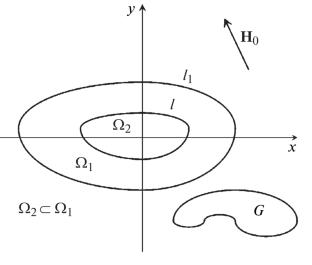均匀磁化体的二维静磁反问题
IF 0.9
4区 材料科学
Q4 MATERIALS SCIENCE, CHARACTERIZATION & TESTING
引用次数: 0
摘要
考虑均匀磁化体的二维静磁反问题,并将其简化为一个非线性一维积分微分方程,该方程根据测量的外磁场强度确定体(腔)的形状。我们设计了一种基于多变量函数最小化的数值求解算法,并开发了实现该算法的FORTRAN程序。为了测试和说明我们的方法,我们根据已知的外场强度,找到了非磁性和不透明介质中均匀无限圆柱体横截面的解。本文章由计算机程序翻译,如有差异,请以英文原文为准。

The 2D Magnetostatics Inverse Problem for a Uniformly Magnetized Body
We consider the 2D magnetostatics inverse problem for a uniformly magnetized body and reduce it to a nonlinear 1D integrodifferential equation determining the body (cavity) shape based on the measured strength of the external magnetic field. We design a numerical algorithm for solution of this equation based on minimization of a function of several variables and develop a FORTRAN program implementing this algorithm. To test and illustrate our approach we find a solution for the cross section of a homogeneous infinite cylinder in a nonmagnetic and opaque medium based on the known strength of the external field.
求助全文
通过发布文献求助,成功后即可免费获取论文全文。
去求助
来源期刊

Russian Journal of Nondestructive Testing
工程技术-材料科学:表征与测试
CiteScore
1.60
自引率
44.40%
发文量
59
审稿时长
6-12 weeks
期刊介绍:
Russian Journal of Nondestructive Testing, a translation of Defectoskopiya, is a publication of the Russian Academy of Sciences. This publication offers current Russian research on the theory and technology of nondestructive testing of materials and components. It describes laboratory and industrial investigations of devices and instrumentation and provides reviews of new equipment developed for series manufacture. Articles cover all physical methods of nondestructive testing, including magnetic and electrical; ultrasonic; X-ray and Y-ray; capillary; liquid (color luminescence), and radio (for materials of low conductivity).
 求助内容:
求助内容: 应助结果提醒方式:
应助结果提醒方式:


